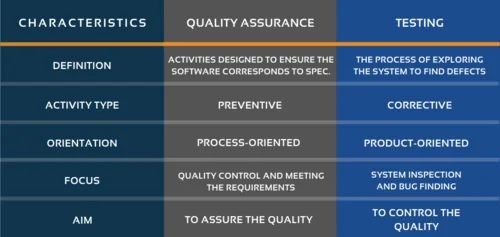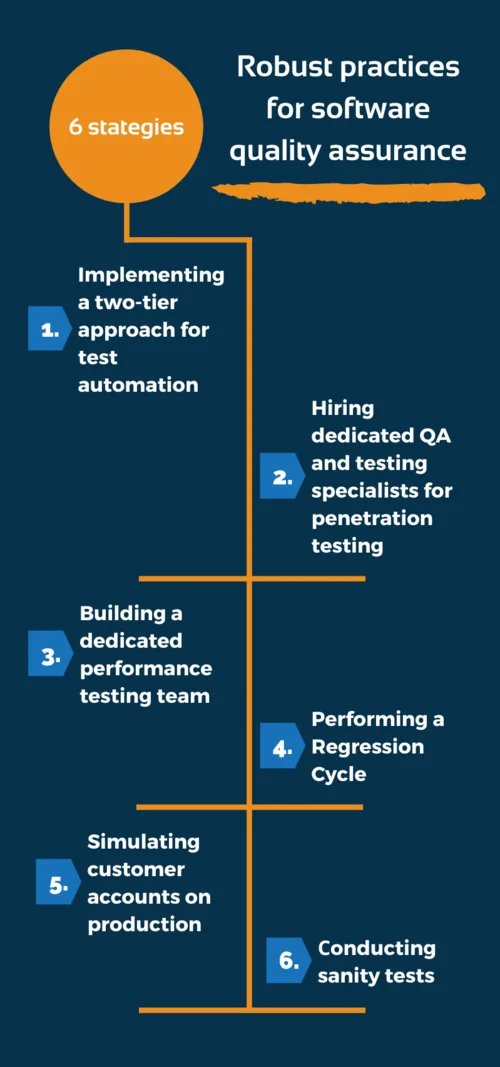Digital Quality Assurance. What is the role of QA in IT development services?


Speaking about the traditional software approach, IT-teams tend to perform QA & Testing services at the final stages of their projects. That is how the QA team’s feedback helps developers to identify shortcomings and resolve problems before the market release. But does it work the same way in 2021? Thanks to the Agile development model, QA experts are free to collaborate with developers during each project stage and enable them to refine the software regularly. It’s quite an improvement, isn’t it?
Quality assurance, as the name implies, focuses on validating if the web-product satisfies the quality requirements. QA has several methods and activities, aimed at setting standard quality benchmarks and preventing bugs. The QA process consists of planning, fulfilling, and monitoring stages. So if the solution hits digital quality assurance benchmarks, it has a good shot at getting the desired result on the IT market.
Although QA and testing work on improving the quality of the product, these notions have different goals. The first one controls the testing process. Software testing, for its part, concentrates on system inspection and bug finding.
If you still need to clarify the difference between the two processes, check out the table below.

Now it’s time to consider the role of Quality Assurance in today’s IT landscape and take a closer look at the QA process. We’ll also discuss the best QA practices to help you meet the required standards.
Many enterprises want their developers to test web products. But even if your IT team does their best to assess the code, dealing with bugs will be a challenging task. Here are a few examples of how quality assurance affects software development:
The Deming cycle of digital QA contains four essential phases, namely:
Plan, Do, Check and Act.

Plan
First and foremost, you should plan and set up main objectives so that developers will decide on relevant features and functionality.
Do
At that stage, the QA team develops and tests standardized processes or corrects existing ones if they fail to satisfy requirements.
Check
As we’ve mentioned before, controlling and modifying all project stages are QA’s primary concerns. It is also critical to estimate if all the changes are consistent with predetermined purposes.
Act
If a current quality of a solution is unsatisfactory, QA experts apply techniques to obtain key improvements.

Sometimes system tests are quite time-consuming, but a two-tier approach operates differently. Every time when there’s a commit to your codebase, the first tier is triggered. The triggers are capable of executing various changes promptly, validating current indicators, and can be utilized with sanity tests. As for the second tier, it carries out exhaustive regression testing, when the team of developers doesn’t work. In such a way, the QA team gets more time to evaluate changes. The challenge lies in the fact that QA experts should find a perfect balance between daytime sanity and nighttime regression testing.
The SaaS model is booming nowadays, so it is significant to perform security testing before each release. Dedicated testing teams conduct full-time penetration testing on web products stable versions. It is better to test all the parts of soon-to-be-released solutions, upgrades, and updates. QA experts should inform testers about unknown product features that may arise during this stage of cooperation. If the testing team is aware of product characteristics, it’s key to a comprehensive analysis of security vulnerabilities.
Conducting only regression tests can be sufficient if the feature set doesn’t impact performance (let’s say that developers delivered additional screen buttons). Otherwise, advanced QA involves compiling new performance tests. And again, it doesn’t hurt to provide testers with the necessary data before they start working. The performance testing team should uncover errors in internal, external, and third-party software-as-a-service environments to prevent crushes.
This step is crucial for moving to the production stage. As a rule, timeframes allow companies to validate entire web products. But what’s the best way of discovering a product from the customer’s perspective? For instance, you can draw up a tree with the hierarchy of branches and components representing product features and a set of functions. Once a particular branch is changed, the hierarchy helps to realize which branch will be affected by the modification. It’s a handy tool to figure out whether you need another digital quality assurance or testing session.
Another important highlight is running data migration testing. In other words, make sure that information remains compatible with new versions of the product. This stage includes managing test accounts on the production system, generating data, and filling in information on your databases. After the release, you need to implement updates to detect the damage of data. First of all, developers should resolve corrupted bugs, and QA + testing teams have to perform manual backward compatibility testing. Regardless of whether QA experts find automatic and more effective instruments, manual testing is a must.
If you are planning to create a high-quality IT engineering solution or service, perform sanity tests on production after the release. Start by testing on current accounts and then validate the processes with the help of the new one. QA teams tend to conduct this type of testing half the time. The team falls into two groups: the first one validates the old account and the second checks the new profile. Finally, all experts test third-party services to ensure the compatibility of versions.
Now you know how to help your solution meet market demands and shine in terms of performance and quality. Your next step is to find an experienced team with a high level of expertise.

PNN Soft provides clients with high-quality programming products. We also deliver stable services for different industries, including Quality Assurance and Testing Solutions. Our QA services include various types of testing, different kinds of testing coverage, and the most demanded testing tools. You may also select a preferable way of cooperation, such as being an integral part of the custom software development process, hiring dedicated QA/testing teams, or outsourcing these services on demand. The company has 20 years of experience in creating highly efficient solutions, but we are continually honing our skills to deliver advanced techs and products.
We are determined to seek innovative solutions that meet individual companies’ needs. That is why we know what technologies spell success for your business today.
PNN Soft takes full advantage of RAD, Scrum, and Agile methodologies to ensure constant communication with customers and build a flexible development process.
If you are searching for an Independent outsourcing service of software QA on demand, fill in the form below.